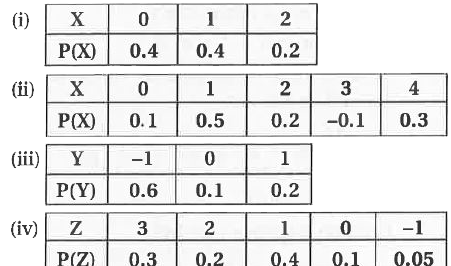Suppose X has a binomial distribution B(6,12). Show that X = 3 is the most likely outcome. (Hint: P(X = 3) is the maximum among all P(x1),x1=0,1,2,3,4,5,6)Solution in Gujrati
Step by step video & image solution for Suppose X has a binomial distribution B(6, (1)/(2)). Show that X = 3 is the most likely outcome. (Hint: P(X = 3) is the maximum among all P(x_(1)), x_(1)= 0,1,2,3,4,5,6) by Maths experts to help you in doubts & scoring excellent marks in Class 12 exams.
Updated on:21/07/2023Topper's Solved these Questions
- PROBABILITYBOOK - KUMAR PRAKASHANCHAPTER - PROBABILITYEXERCISE - MISCELLANEOUS EXERCISE 13
20 Videos
- PROBABILITYBOOK - KUMAR PRAKASHANCHAPTER - PROBABILITYEXERCISE - Textbook Illustrations for Practice Work
37 Videos
- PROBABILITYBOOK - KUMAR PRAKASHANCHAPTER - PROBABILITYEXERCISE - EXERCISE -13.4
20 Videos
- MATRICES BOOK - KUMAR PRAKASHANCHAPTER - MATRICES EXERCISE - Practice Paper - 3 (Section - D)
1 Videos
- RELATIONS AND FUNCTIONS BOOK - KUMAR PRAKASHANCHAPTER - RELATIONS AND FUNCTIONS EXERCISE - Practice Paper - 1 (Section - D)
2 Videos
Similar Questions
A and B are two events such that P(A)≠0. Find P(B|A), if
(i) A is a subset of B (ii) A∩B=ϕ
View SolutionIf P(A)=713,P(B)=913 and P(A∩B)=413 evaluate P(A∣B)
View SolutionState which of the following are not the probability distributions of a random variable. Give reasons for your answer.

View SolutionFor matrix A=⎡⎢⎣11112−32−13⎤⎥⎦ . Prove that , A3−6A2+5A+11I=0. Hence find A−1 using it .
View SolutionLet : f:N→N be defined by f(n)={n+12 if n is oddn2 if n is even for all n∈N .
State whether the function f is bijective . Justify your answer.
View SolutionSuppose X has a binomial distribution B(6,12). Show that X=3is the most likely outcome.(Hint: P(x=3)is the maximum among all P(xi),xi=0,1,2,3,4,5,6)
View SolutionValue of ∣∣ ∣ ∣∣1+x11+x1x1+x1x21+x21+x2x1+x2x21+x31+x3x1+x3x2∣∣ ∣ ∣∣ depends upon
View Solutionमान लीजिये की X का बंटन B(6,12) द्विपद बंटन है। दर्शाया कि X=3 अधिकतम प्रायिकता वाला परिणाम है।
(संकेत: P(X=3) सभी P(xi),xi=0,1,2,3,4,5,6 में से अधिकतम है।
View SolutionValue of ∣∣ ∣ ∣∣1+x11+x1x1+x1x21+x21+x2x1+x2x21+x31+x3x1+x3x2∣∣ ∣ ∣∣ depends upon
View SolutionLet x,x1,x2,x3,x4,...,x8, be 10 real zeros, of the polynomial P(x)=x10+ax2+bx+c where a,b,c,∈R. If the value of Q(x1)=pq, where p and q are coprime to each other. If Q(x1)=(x−x2)(x−x3)...(x−x8)andx1=12, then the value of q−p is.......
View Solution(a) Obtain binomial probability distribution, if :
(i) n=6,p=13 (ii) n=5,p=16.
(b) Suppose X has a binomial distribution B(6,12).
Show that X = 3 is the most likely outcome.
View Solutionsuppose X has a binomial distribution B(6,12) . Show that X = 3 is the most likely outcome.
View SolutionSuppose X has binomial distribution B(6,12). Show that X = 3 is the most likely outcome.
View SolutionSuppose X has a binomial distribution B(6,12). Show that X = 3 is the most likely outcome. (Hint: P(X = 3) is the maximum among all P(x1),x1=0,1,2,3,4,5,6)
View SolutionSuppose X has a binomial distribution B(6,12). Show that X = 3 is the most likely outcome. (Hint: P(X = 3) is the maximum among all P(x1),x1=0,1,2,3,4,5,6)
View SolutionSuppose X has a binomial distribution B(6,12). Show that X = 3 is the most likely outcome. (Hint: P(X = 3) is the maximum among all P(x1),x1=0,1,2,3,4,5,6)
View Solution
